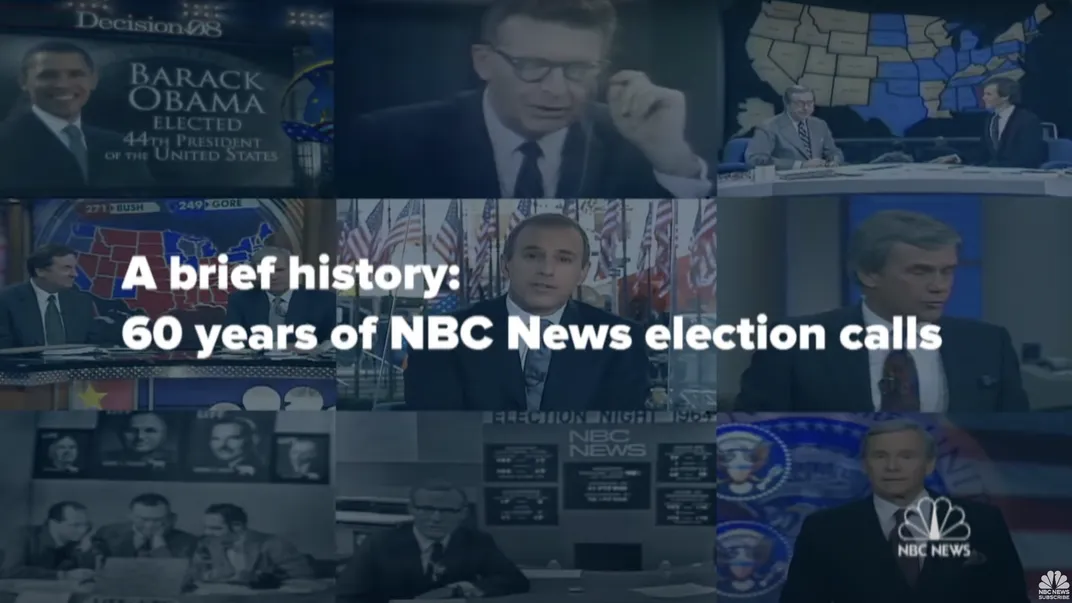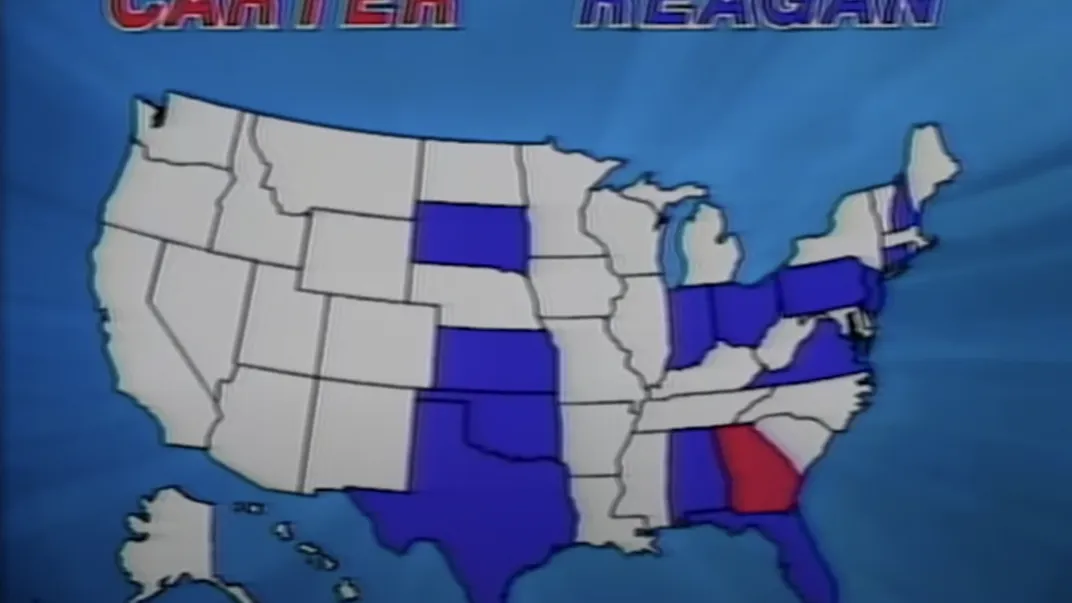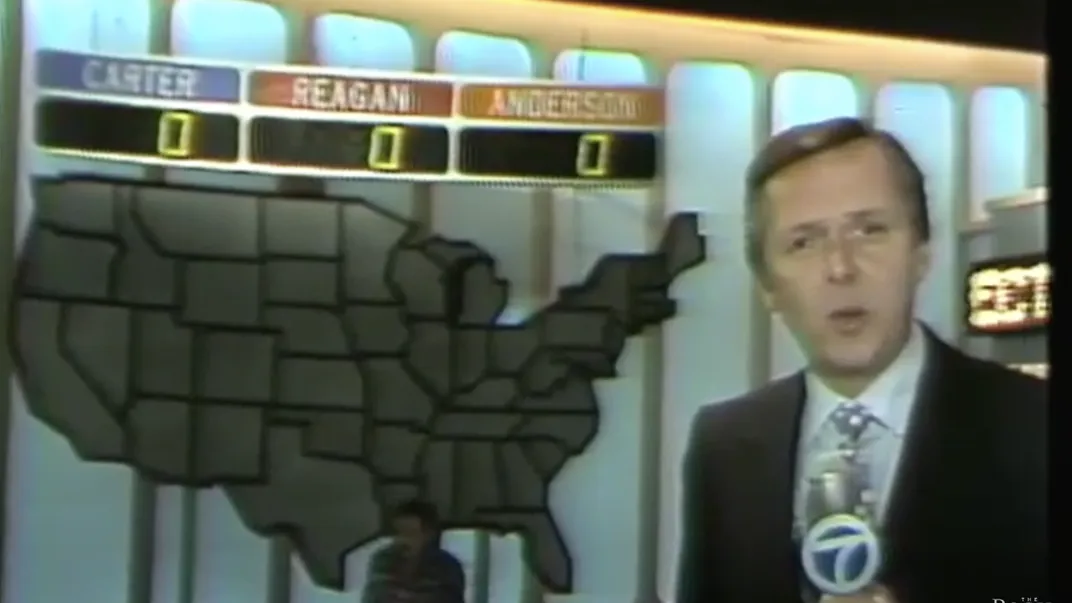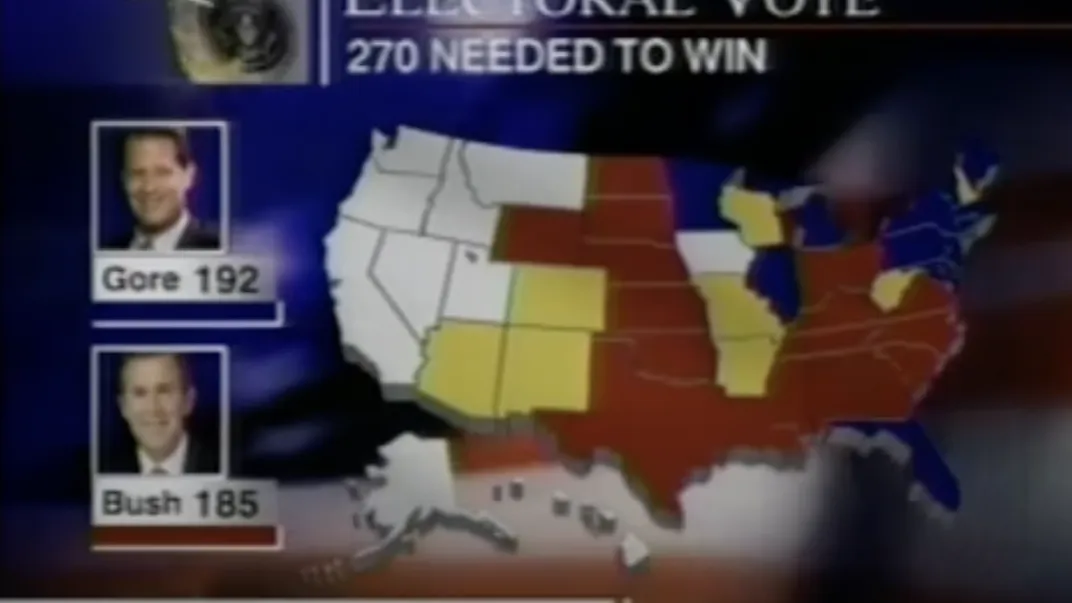When Republicans Became ‘Red’ and Democrats Became ‘Blue’
The 2000 presidential election cemented the color-coded nature of political parties. Prior to that race, the colors were often reversed on electoral maps
:focal(700x527:701x528)/https://tf-cmsv2-smithsonianmag-media.s3.amazonaws.com/filer_public/06/54/06540816-c843-41d0-9eeb-67e7a87bef02/electoral-map.jpg)
Television’s first dynamic, color-coded presidential map, standing two stories high in the studio best known as the home of “Saturday Night Live,” was melting.
It was early October 1976, the month before the map was set to debut—live—on election night. At the urging of anchor John Chancellor, NBC had constructed the behemoth map to illustrate, in vivid blue and red, which states supported Republican incumbent Gerald Ford and which backed Democratic challenger Jimmy Carter.
The test run didn’t go well. Although the map was buttressed by a sturdy wooden frame, the front of each state was plastic.
“There were thousands of bulbs,” Roy Wetzel, who was the newly minted general manager of NBC’s election unit when the map debuted in 1976, recalled to Smithsonian magazine in 2012. “The thing started to melt when we turned all the lights on. We then had to bring in gigantic interior air conditioning and fans to put behind the thing to cool it.”
That solved the problem. And when election results flowed in on the night of November 2, 1976, Studio 8H at 30 Rockefeller Plaza in New York City lit up. Lightbulbs on each state changed from undecided white to Republican blue and Democratic red. NBC declared Carter the winner at 3:30 a.m. Eastern Time, when Mississippi turned red.
That’s right: In the beginning, the blue political party was red, and the red party was blue. For more than two decades, the colors changed back and forth depending on the election year and the network, in what appears, in hindsight, to be a flight of whimsy. The notion that there were “red states” and “blue states”—and that the former were Republican and the latter Democratic—wasn’t ingrained in the national psyche until 2000, when the United States Supreme Court effectively awarded Florida’s 25 electoral votes to Governor George W. Bush of Texas, cementing his victory over incumbent Vice President Al Gore.
Twenty-four years later, amid a growing divide between liberal and conservative Americans, Vice President Kamala Harris appears to be in a very tight race against former President Donald J. Trump in the polls and forecasts. Come November 5, pundits predict that the West Coast and the Northeast will likely be bathed in blue. The country’s geographic center, meanwhile, will likely be awash in red.
As evidenced by Trump’s surprise victory in the 2016 presidential election, forecasts and predictions are just that. Ultimately, a handful of swing states—including Arizona, Georgia and Pennsylvania—will determine the winner, starting out in neutral tones before shifting, one by one, to red or blue. If enough of these battleground states turn blue, Harris will move into the White House on January 20, 2025. If enough turn red, Trump will return to the nation’s highest office four years after he lost the 2020 election. For now, the undecided states are considered “purple.”
/https://tf-cmsv2-smithsonianmag-media.s3.amazonaws.com/filer_public/50/63/50630981-b7c6-4df4-b2ed-384aa0e39c93/gettyimages-515428156.jpg)
Here’s something else we know: All the maps—on TV stations and websites on election night and in newspapers the next morning—will look alike. Viewers won’t have to switch their thinking as they switch channels, wondering which candidate is blue and which is red. But prior to 2000, there was no uniformity in the maps that television stations, newspapers or magazines used to illustrate presidential elections. After that election, pretty much everyone embraced red and blue, but the color representing each party varied, sometimes by organization, sometimes by election cycle.
The connotations of red and blue
Some theories that seek to explain the shifting palette seem reasonable, while others are just plain weird. History plays a role: Prior to the 21st century, the Republican Party was more often associated with blue than red. During the Civil War, the Union Army, led by Republican Abraham Lincoln, wore blue uniforms. “Internationally,” CNN noted, “blue is often linked with wealth and conservatism, having historically been the most expensive color to produce. Red, meanwhile, has long been associated with radicalism”—and, in the late 20th century, communism.
As Chuck Todd, then political director and chief White House correspondent for NBC News, said in 2012, “For years, both parties would do red and blue maps, but they always made the other guys red. During the Cold War, who wanted to be red?”
Indeed, prior to the breakup of the Soviet Union in 1991, “red was a term of derision,” said journalist Mitchell Stephens in 2012. “There’s a movie named Reds. You’d see red in tabloid headlines, particularly in right-wing tabloids like … the New York Daily News.”
Perhaps the stigma surrounding red explains why some networks changed colors—in what appeared to be random fashion—in the early days of color television. In 2004, Kevin Drum of Washington Monthly wrote that networks alternated colors based on the party of the White House incumbent, but that doesn’t appear to be the case for every election.
In 1976, the same year that NBC debuted its mammoth electronic map, ABC News employed a small, rudimentary version that used yellow for Ford, blue for Carter and red for states in which votes had yet to be tallied. In 1980, NBC again used red for Carter and blue for the Republican challenger, Ronald Reagan. (As Reagan secured a decisive lead, NBC anchor David Brinkley likened the network’s increasingly blue electoral map to “a suburban swimming pool.”) CBS followed suit.
But ABC flipped the NBC color scheme, using blue for Carter, red for Reagan and orange for states won by John Anderson, a third-party candidate who received 6.6 percent of the popular vote. Anderson carried no states, and orange seems to have gone by the wayside in the races that followed.
NBC’s electoral map “was groundbreaking in that it was constantly on the screen,” Douglas Manning, son of NBC executive Gordon Manning, told the Los Angeles Times in 2016. “Now we’ve become accustomed to seeing visuals crawling across the lower third of the screen and everything else that was going on. This was a first step. You could draw your own conclusion on how things were evolving without the anchors having to utter a word.”
Four years later, in 1984, ABC and CBS used red for Republicans and blue for Democrats—but the combination wouldn’t stick for another 16 years. During the four presidential elections that Wetzel oversaw for NBC, from 1976 to 1988, the network never switched colors. Republicans were cool blue, and Democrats were hot red.
The reasoning was simple: Great Britain.
“Without giving it a second thought, we said blue for conservatives, because that’s what the parliamentary system in London is, red for the more liberal party,” said Wetzel, who is now retired. “And that settled it. We just did it.”
Forget all that communist red stuff, he added. “It didn’t occur to us. When I first heard it, I thought, ‘Oh, that’s really silly.’”
It was only in 2000 that NBC standardized its map to match the colors used by ABC and CBS. The network wanted to avoid “confusion for the viewers” flipping between channels on election night, NBC executive William Wheatley told Vox in 2016.
The 2000 presidential election
For much of the 20th century, newspapers were largely black and white, meaning most printed electoral maps were differentiated by shades of contrast, not color. By 1993, however, 97 percent of North American newspapers printed at least some of their pages in color, according to the New York Times.
Two days after voters went to the polls on November 7, 2000, the Times and USA Today published their first color-coded, county-by-county maps detailing the showdown between Gore and Bush. Both papers used red for the Republican Bush and blue for the Democrat Gore.
Why?
“I just decided ‘red’ begins with ‘r,’ ‘Republican’ begins with ‘r.’ It was a more natural association,” said Archie Tse, then a senior graphics editor at the Times, in 2012. “There wasn’t much discussion about it.”
Also in 2012, Paul Overberg, a database editor who designed the map for USA Today, said he was following a trend: “The reason I did it was because everybody was already doing it that way at that point.”
And everybody had to continue doing it for a long time. The 2000 election dragged on until mid-December, when the Supreme Court stopped the vote recount in Florida and handed the presidency to Bush. For weeks, the maps were ubiquitous.
Perhaps that’s why the 2000 colors stuck. Along with images of Florida elections officials eyeballing tiny chads on paper punch-card ballots, the maps were there constantly, reminding viewers of the vast, nearly even divide between red and blue voters.
From an aesthetic standpoint, the current color scheme fits with the political landscape, Overberg said. Republicans typically dominate in larger, less populated states in the Plains and Mountain West, meaning the center of the United States is very red. “If it had been flipped, the map would have been too dark,” he explained. “The blue would have been swamping the red. Red is a lighter color.”
But not everyone liked the shift. Republican operative Clark Bensen criticized the change in a 2004 essay titled “Red State Blues: Did I Miss That Memo?”
“There are two general reasons why blue for Republican and red for Democrat make the most sense: connotation and practice,” Bensen wrote. “First, there has been a generally understood meaning to the two colors inasmuch as they relate to politics. That is, the cooler color blue more closely represented the rational thinker and cold-hearted, and the hotter red more closely represented the passionate and hot-blooded. This would translate into blue for Republicans and red for Democrats.”
At this point—six presidential elections after the Supreme Court’s Bush v. Gore decision—the color arrangement seems unlikely to change any time soon. The terms “red states” and “blue states” have entered the lexicon, and partisans on both sides have taken ownership of them. For instance, RedState is a conservative blog; Blue State Digital, which grew out of Democrat Howard Dean’s 2004 presidential campaign, helps candidates and organizations use technology to raise money, advocate their positions and connect with constituents. In 2008, a Republican and a Democrat even joined forces to create Purple Strategies, a bipartisan public affairs firm.
In 2012, Sara Quinn, a visual journalist then affiliated with the Poynter Institute, said she saw no particular advantage to either color.
“Red is usually very warm, and it comes forward to the eye,” she added. “Blue tends to be a recessive color, but a calming color.”
Color connotations aside, the 2000 election marked the moment when red and blue “became part of the national discourse,” Tse said. “You couldn’t do it any other way.”






/https://tf-cmsv2-smithsonianmag-media.s3.amazonaws.com/accounts/headshot/mellon.png)

